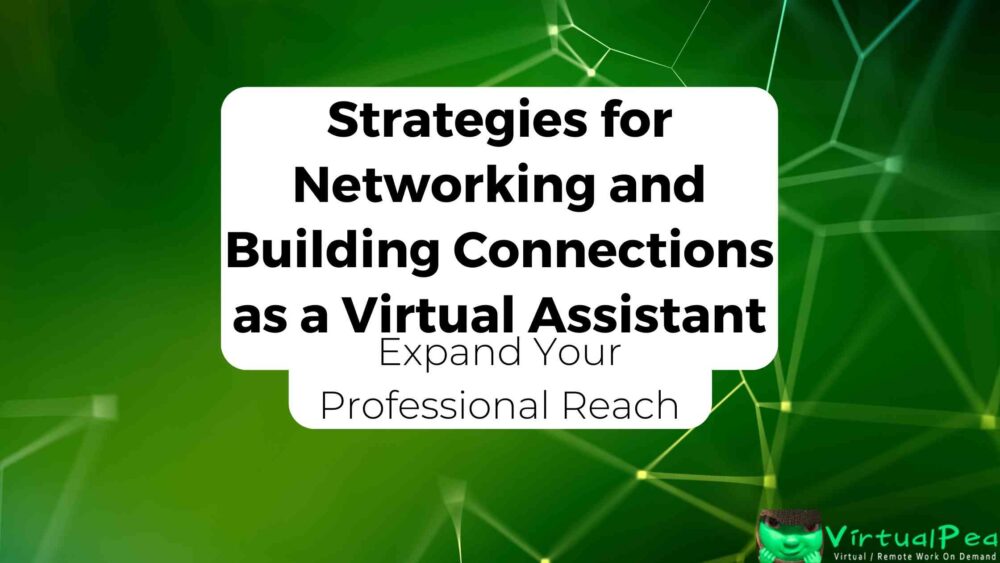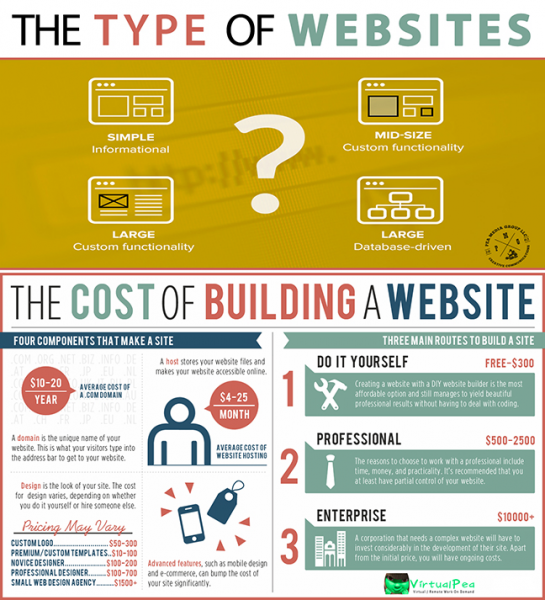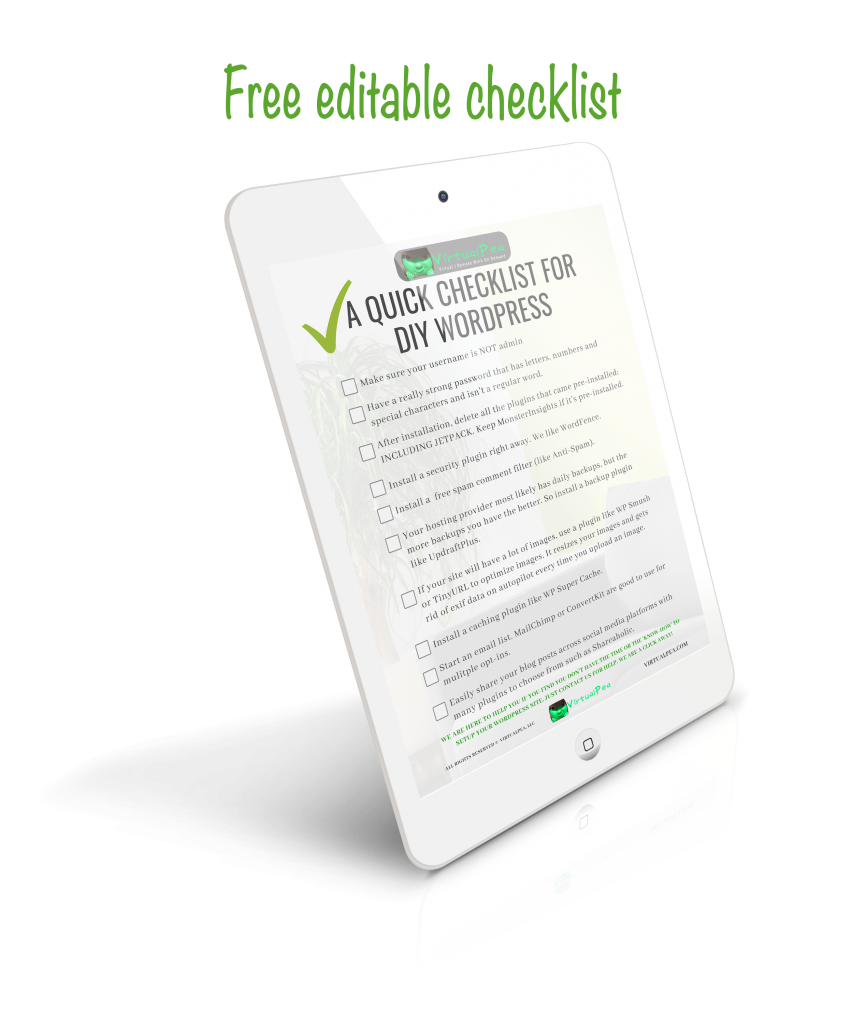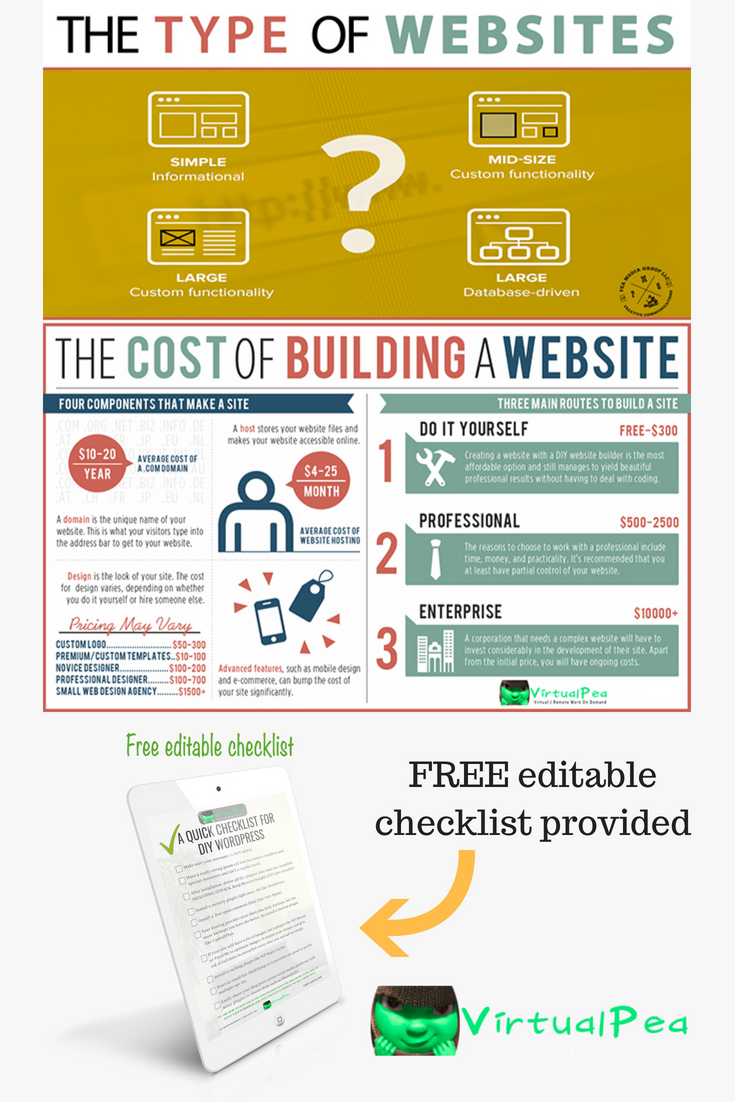
As a virtual assistant, networking and building connections are essential for expanding your professional reach, attracting new clients, and fostering collaborations. While traditional networking events may not be readily available, there are numerous online platforms and strategies you can leverage to build meaningful relationships and enhance your virtual assistant career. In this blog post, we will explore effective strategies for networking and building connections as a virtual assistant, including utilizing online networking platforms, participating in industry events, and implementing relationship-building techniques.
1. Utilize Online Networking Platforms
Online networking platforms offer a wealth of opportunities to connect with professionals from various industries. Create profiles on platforms such as LinkedIn, Upwork, or Freelancer, highlighting your skills, experience, and services as a virtual assistant. Actively engage in industry-specific groups and forums, share valuable insights, and connect with like-minded professionals. Utilize the power of social media platforms to join relevant communities, participate in discussions, and showcase your expertise.
2. Participate in Virtual Industry Events
Attending virtual industry events is an excellent way to network and build connections as a virtual assistant. Look for webinars, conferences, and workshops related to your niche or the virtual assistant industry. Engage actively during these events by asking questions, sharing your knowledge, and connecting with speakers and fellow participants. Follow up with personalized messages or emails after the event to nurture those connections further.
3. Leverage Online Communities and Forums
Online communities and forums provide valuable platforms for virtual assistants to connect and share experiences. Join relevant communities, such as specialized virtual assistant groups, freelance forums, or professional networks. Contribute by providing valuable insights, answering questions, and engaging in conversations. Building your presence within these communities can lead to meaningful connections and potential collaborations.

4. Implement Relationship-Building Techniques
Networking is not just about exchanging business cards; it’s about building meaningful relationships. Implement relationship-building techniques to establish strong connections with fellow professionals. Take the time to understand their needs and challenges, and offer support or assistance when possible. Actively listen, engage in meaningful conversations, and show genuine interest in their work. Building trust and rapport will lead to long-term professional relationships.
5. Collaborate with Other Virtual Assistants
Collaboration with other virtual assistants can be mutually beneficial and help expand your professional network. Seek opportunities to partner on projects, share referrals, or co-create content. Participate in virtual assistant mastermind groups or create your own network of like-minded professionals. Collaborative relationships not only enhance your skillset but also open doors to new clients and opportunities.
6. Maintain a Professional Online Presence
Having a professional online presence is crucial for networking success. Optimize your website or online portfolio to showcase your skills, experience, and services. Keep your social media profiles up-to-date and share relevant content that highlights your expertise as a virtual assistant. Regularly engage with your online audience by responding to comments, messages, and inquiries promptly. A polished online presence demonstrates professionalism and attracts potential clients.
Networking and building connections are fundamental aspects of being a successful virtual assistant. By utilizing online networking platforms, participating in virtual industry events, leveraging online communities and forums, implementing relationship-building techniques, collaborating with other virtual assistants, and maintaining a professional online presence, you can expand your professional reach, attract new clients, and unlock exciting opportunities in the virtual assistant industry. Embrace these strategies, be proactive, and nurture your connections to cultivate a thriving network of professional relationships.
Remember, networking is a continuous process. Stay active, attend virtual events, engage in online communities, and nurture your connections to build a strong and supportive professional network as a virtual assistant.

As a virtual assistant, one of your key responsibilities may involve creating engaging content for your clients. Whether it’s blog posts, social media updates, newsletters, or website copy, the quality and effectiveness of your content can greatly impact your clients’ online presence. In this comprehensive guide, we will share valuable tips and techniques to help you create compelling and engaging content as a virtual assistant.
1. Understand Your Client’s Brand and Target Audience
Before creating content, it’s essential to understand your client’s brand identity and target audience. Familiarize yourself with their brand voice, values, and messaging. This knowledge will guide your content creation process and help you create content that resonates with the target audience.
2. Research and Stay Updated on Industry Trends
Stay up-to-date with the latest industry trends and developments in your client’s niche. Conduct thorough research to understand the topics, keywords, and formats that are popular and relevant to the target audience. This will enable you to create content that is timely and valuable.
3. Develop a Content Strategy
Create a content strategy that aligns with your client’s goals and objectives. This involves planning the types of content to create, the platforms to publish on, and the frequency of posting. A well-defined content strategy ensures consistency and helps you deliver content that supports your client’s overall marketing efforts.
4. Write Compelling Headlines and Introductions
Craft attention-grabbing headlines and introductions to captivate your audience from the start. Use strong and compelling language, pose intriguing questions, or highlight the benefits of reading the content. A compelling headline and introduction will entice readers to continue reading.

5. Incorporate Visual Elements
Engage your audience visually by incorporating relevant and eye-catching visuals in your content. This includes images, infographics, videos, or charts that enhance the readability and appeal of the content. Visual elements help break up text and make the content more engaging.
6. Tell Stories and Use Personal Examples
Storytelling is a powerful technique to captivate readers and make your content relatable. Incorporate anecdotes, personal examples, or case studies to illustrate your points and connect with the audience on a deeper level. Stories create an emotional connection and keep readers engaged.
7. Use a Conversational Tone
Write in a conversational tone to make your content more approachable and relatable. Avoid using jargon or complex language that might alienate readers. Instead, aim for clarity, simplicity, and a friendly tone that resonates with your audience.
8. Incorporate Call-to-Actions (CTAs)
Include clear and compelling call-to-actions in your content to guide readers towards the desired action. Whether it’s subscribing to a newsletter, sharing the content, or making a purchase, CTAs prompt readers to take the next step and engage further with your client’s brand.
Creating engaging content as a virtual assistant is an important skill that can elevate your clients’ online presence and drive results. By understanding your client’s brand, staying updated on industry trends, developing a content strategy, and incorporating writing techniques such as compelling headlines, storytelling, and visual elements, you can create content that captivates your audience and achieves the desired outcomes.

Marketing your virtual assistant services effectively is essential for attracting clients and building a successful freelance business. With the increasing demand for remote work, it’s crucial to utilize online marketing strategies to stand out in a competitive landscape. In this article, we will explore effective ways to market your virtual assistant services online. From leveraging social media platforms to implementing content marketing tactics, these strategies will help you promote your services, attract clients, and establish a strong online presence.
1. Define Your Target Audience
Before you start marketing your virtual assistant services, it’s essential to define your target audience. Identify the specific types of clients you want to work with, such as entrepreneurs, small business owners, or professionals in a particular industry. Understanding your target audience will help you tailor your marketing efforts to resonate with their needs and preferences.
2. Build a Professional Website
A professional website is the cornerstone of your online presence. Create a user-friendly website that showcases your virtual assistant services, highlights your skills and experience, and includes testimonials or case studies from satisfied clients. Optimize your website with relevant keywords and ensure it loads quickly on both desktop and mobile devices. Include a clear call-to-action (CTA) to encourage potential clients to reach out or request more information.

3. Utilize Social Media Platforms
Social media platforms provide an excellent opportunity to promote your virtual assistant services and engage with potential clients. Identify the platforms where your target audience is most active and create compelling profiles. Regularly share valuable content related to your services, industry insights, and tips that demonstrate your expertise. Engage with your audience by responding to comments and messages promptly. Consider running targeted ads or sponsored posts to reach a wider audience.
4. Leverage Content Marketing
Content marketing is a powerful strategy for showcasing your expertise and attracting clients. Create valuable and informative content through blog posts, articles, or video tutorials that address common challenges faced by your target audience. Optimize your content with relevant keywords to improve search engine visibility. Share your content on your website, social media platforms, and relevant online communities to establish yourself as an authority in the virtual assistant industry.
5. Network and Collaborate
Networking and collaborating with other professionals in your industry can help expand your reach and attract clients. Join online communities, professional organizations, and virtual assistant forums where you can connect with potential clients and build relationships with peers. Offer your expertise through guest blogging or participating in webinars or podcasts. Collaborate with complementary service providers to offer bundled services or cross-promote each other’s businesses.
Marketing your virtual assistant services effectively online is crucial for attracting clients and growing your freelance business. By defining your target audience, building a professional website, utilizing social media platforms, leveraging content marketing, and networking with peers, you can establish a strong online presence and showcase your expertise.

As a virtual assistant, building a professional online presence is essential for establishing credibility, attracting clients, and showcasing your expertise. In today’s digital age, potential clients often rely on the internet to find and evaluate virtual assistants. In this article, we will explore effective strategies to build a strong and reputable online presence as a virtual assistant.
1. Create an Impressive Online Portfolio
A well-designed online portfolio is crucial for showcasing your skills, experience, and the services you offer. Include a professional bio, highlight your expertise and achievements, and provide examples of your work. Use a clean and user-friendly layout that reflects your personal brand. Ensure your portfolio is mobile-friendly, as many potential clients browse on their smartphones or tablets.
2. Develop a Consistent Branding Strategy
Consistent branding helps you stand out and creates a memorable impression. Choose a professional logo, color scheme, and typography that align with your niche and target market. Use these elements consistently across your website, social media profiles, and other online platforms. A cohesive and visually appealing brand will enhance your professional image and make you easily recognizable.

3. Optimize Your Website for Search Engines
Having a website is crucial for establishing your online presence. Optimize your website for search engines by using relevant keywords in your content, titles, and meta tags. Create valuable and informative content that showcases your expertise and attracts potential clients. Ensure your website is mobile-responsive and loads quickly, as these factors can impact search engine rankings.
4. Leverage Social Media Platforms
Social media platforms provide excellent opportunities to connect with potential clients and showcase your expertise. Choose platforms that align with your target market and focus on building a strong presence there. Share relevant content, engage with your audience, and participate in industry-related discussions. Utilize social media scheduling tools to maintain a consistent posting schedule and maximize your reach.
5. Network with Peers and Industry Professionals
Networking is essential for building your online presence and establishing connections within the virtual assistant community. Join online communities, participate in forums, and engage in discussions. Collaborate with other professionals, offer assistance, and share your knowledge. Building relationships with peers and industry professionals can lead to referrals and new opportunities.
Building a professional online presence is crucial for virtual assistants to attract clients, establish credibility, and showcase their expertise. By creating an impressive online portfolio, developing a consistent branding strategy, optimizing your website for search engines, leveraging social media platforms, and networking with peers and industry professionals, you can establish a strong and reputable image as a virtual assistant. Embrace these strategies, consistently refine your online presence, and position yourself as a trusted and sought-after professional in the virtual assistance industry.

As a virtual assistant, developing a niche and standing out in a crowded marketplace is key to attracting clients who value your unique skills and expertise. By specializing in a specific area, you can position yourself as an expert and offer tailored solutions to meet the needs of your target market. In this article, we will explore practical tips on how to develop a niche as a virtual assistant and stand out from the competition.
1. Identify Your Unique Skills and Passion
Start by assessing your skills, strengths, and interests. Identify areas where you excel and have a genuine passion. Consider your previous work experience, training, or any specialized knowledge you possess. This self-reflection will help you discover your unique abilities and narrow down potential niches that align with your expertise and interests.
2. Research Your Target Market
Conduct thorough research to understand your target market and their specific needs. Identify industries or sectors that require virtual assistant services and determine the challenges they face. Look for gaps or opportunities where your skills and expertise can provide valuable solutions. By understanding your target market’s pain points, you can tailor your services to address their specific needs effectively.

3. Offer Specialized Services
Once you have identified your niche and target market, develop specialized services that cater to their unique requirements. Focus on offering solutions that differentiate you from general virtual assistant services. For example, if you specialize in social media management, you can offer comprehensive social media strategies, content creation, and analytics. By positioning yourself as an expert in a specific area, you can attract clients seeking specialized support.
4. Showcase Your Expertise
Demonstrate your expertise and showcase your knowledge through various channels. Create a professional website or portfolio that highlights your specialized skills and showcases successful projects or testimonials from satisfied clients. Leverage social media platforms and industry-specific online communities to share valuable insights, engage with potential clients, and establish yourself as an authority in your niche.
5. Network and Collaborate
Build relationships and network with professionals in your niche and related industries. Attend virtual events, join online communities, and engage in conversations to expand your network. Collaborate with other professionals or businesses in complementary fields to offer joint services or referral programs. By building a strong network and collaborating with others, you can tap into new opportunities and increase your visibility within your niche.
Developing a niche as a virtual assistant is crucial for standing out in a competitive market. By identifying your unique skills, researching your target market, offering specialized services, showcasing your expertise, and building a strong network, you can differentiate yourself and attract clients who value your niche expertise. Embrace your specialization, deliver exceptional services, and consistently refine your skills to become a sought-after virtual assistant in your chosen niche.

We receive inquiries from various entrepreneurs about the cost to build websites. For some of them that are just starting out, they have big ideas and are very optimistic about the success of their business through their websites. However, they tend to not account for the cost of their ideas which is usually a bit more than they budget for if they have a budget at all.
Usually, this is because they aren’t privy to the cost or the structure until we share with them the breakdown of their web project based on their ideas. At that point, they want to know ‘how much does it cost to build’ and ‘how long does it take to make a website’. In an effort to never crush their dreams, we provide the steps, timeframe, and the cost of their web project in phases.
Do what you can to help any entrepreneur's dream become a reality! #entrepreneurslife #sharethelove Share on XThis works out well for some. For others, they choose to either do it themselves or wait until they are ready financially to get it done professionally. Either way, we do what we can to help any entrepreneur’s dream become a reality. Let’s go over some details about the types of websites and the average cost of websites.
The Type of Website
So what type of website would you like to build? That’s the first question you want to get really clear on.
There are simple, informational websites: the one-pagers, lead/landing pages, or the ones with about 5 pages such as Home, About Us, Services, Blog, Contact Us pages. These are great to use to start your business to get your information up and out to the world. They are also great for different freebies you want to create to pull in more leads for your business. And even great for information about a product or service you’d like to promote or a resume/CV, or a pitch deck or any type of report (i.e. annual report) you’d like to make available online with downloadable content.
There are mid-size, custom functioning websites: the sites that promote events and allow people to sign-up for the event, or the booking systems that allow visitors to schedule appointments. These sites are great for the entrepreneur that is ready to take the CEO seat and run a business.
There are large-size, custom functioning websites: similar to the mid-size, custom functioning site yet larger with a few more features such as the ability to sell products from the site (eCommerce), book appointments, or register for online or offsite events.
And then we have the large, database driven websites: these are sites such as hospitality sites that require reservations/booking rooms and banquet halls, or an online store with over 1000 products, or real estate sites connecting to IDX systems.
Four Components That Make a Site
There are 4 basic components that make a website:
- Domain – You will need to register a domain name for your website. This is your address where your website is located on the world wide web.
- Hosting – This involves a server to store all of your web files, email accounts, databases, and scripts that causes your web presence to function.
- Design/look of your site – Your company branding is what drives the look of your web presence which includes optimized graphics throughout your website and in your blog posts.
- Features to help your site be a great business tool – There are many features to add to your site to help your visitors sign up, register for events, schedule for appointments with you, purchase your services/products, interact with you and your business, gather analytics to get to know your audience, optimize your site for SEO and load fast, and many more features that suits your business.
Let’s Get to the Costs
We’ve broken this down to 3 routes you can take to build a site that is suitable for your business and your business budget.
- You can do it yourself! Sometimes this option is best. If you’re just starting out and you didn’t actually factor in a budget to handle the the cost of building your website, doing it yourself can be a good option with great success. The cost ranges from $0 – $500. There are now many DIY website builders out there where you can put up a site with ease and no coding.
- You can go with a Professional website in the range of $500 – $2500 with ease. This can go up to $5000-$8000 with added features and a customized platform. Entrepreneurs that are upgrading from their DIY websites or those that are rebranding go with this type of site. Over time they upgrade to a well tailored site that suits the needs of their business and provide ease and a more upgraded user experience for their visitors potentially converting them into clients/customers/buyers.
- Most corporations and some small businesses go for the Enterprise website investing in amounts starting at $10,000. These are well developed, customized and complex websites.
There are many different routes to take to get your website just right for your business. You can choose platforms such as Squarespace or WordPress. If things become too technical for you to continue buidling your website this way, let us help you with it. Just contact us or click to chat (below) with our Success Team and we will get you just what you need.
Grab our FREE, editable website checklist to help you while building your WordPress website. It gives a few great tips.
Understanding the Base Price of a DIY WordPress Website
Are you deciding to go the DIY route to put your WordPress site? A typical breakdown of expenses required to get up and running might look something like this:
Domain: $15/year
Hosting: $10/month – $30/month
Premium Theme: $50-$200
Premium Plugins: $15-$200 (each; some are one-time purchases, others are monthly/annual licenses.)
Rough Totals: $200-$1,000+
Turnkey WordPress Setup & Maintenance
Here’s a few models we’ve seen:
Hourly: $50-$100 per hour
Flat Rate: $500-$1000+
Monthly: $30-$50/month (in addition to the initial hourly or flat rate fees)
A-la-cart Extras: $100, $200, etc. per strategy document, training course, and so on.
Rough Totals: $500-$2,500+ (plus possible monthly or a-la-cart services)
Custom WordPress Design/Development
This type of custom design requires one to be proficient in PHP, CSS, Javascript, and MySQL which we are.
Many custom WordPress design and development work falls within the following price ranges:
Custom WordPress Theme: $3,000-$6,000 (for design and development)
Custom WordPress Website: $6,000-$15,000 (for design and development, with custom plugin functionality)
Custom WordPress eCommerce Site: $6,000-$20,000
Custom WordPress Web App: $15,000-$60,000+
Your website feels like a great deal when the value you get back in the form of it is greater than the money you invested. #success Share on X
At the end of the day, it doesn’t matter how much something costs as long as you come away feeling like you have a great deal. That only happens when the value you get back in the form of your website is greater than the money you invested. This is just as possible at $20,000 as it is at $500. It’s all in how the process is managed.


